The Backyard Office
Work-from-home studios are having a moment, driven in part by pandemic trends; newbies and veterans alike speak to the merits of a space of one’s own.
Liz Beatty had already started planning a backyard recording and work studio at her home in Brimstone when the pandemic struck in 2020 – but that’s when the project became all the more urgent for the award-winning travel podcaster and feature writer.
“After decades alone during the day to work, suddenly I’ve got my husband home – every day. And I say, with great affection, he is a very loud talker,” explains the host and executive producer of the North Americana podcast. “I can’t count the number of recording takes ruined by his work calls – ‘How you doin’, Bob?’ Or ‘Petunia! Walk time!’ And then our basset hound’s toenails on the tile. Something had to give.”
Liz highly recommends the path she took, calling her 12-by-14-foot Nordic-style “gal cave” a game changer – she even renamed her company Black Cabin Studio. Her workspace, with its white walls, a vaulted ceiling, modern couch and Eames chair, is a gracious backdrop to her creative endeavours, which include writing for In The Hills. It doesn’t hurt that the only sound is the wind in the trees and the creek babbling behind it.
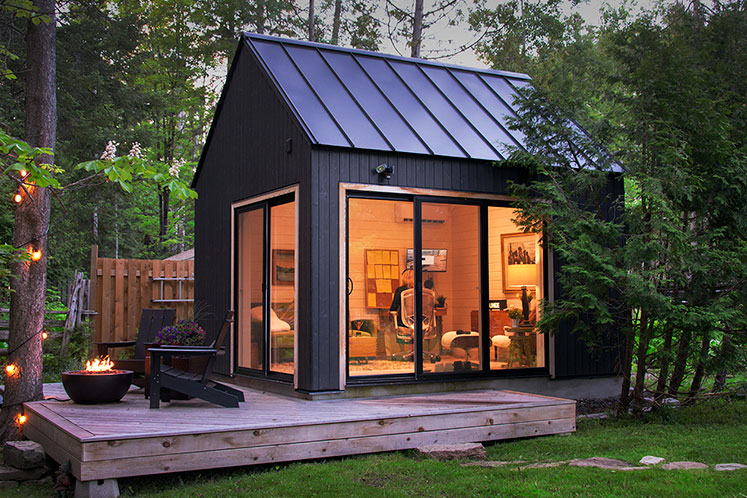
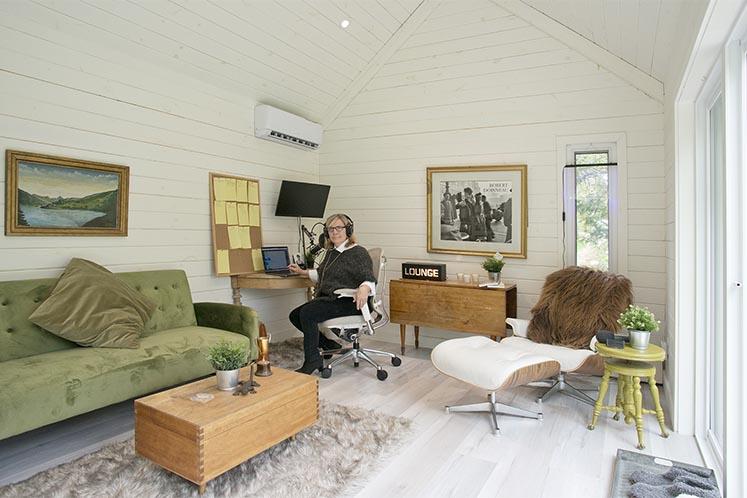
Brimstone writer and podcaster Liz Beatty at work in the backyard recording and work studio she had built in 2020. The Nordic-style cabin, top right, was designed and installed by Toronto-based prefab makers Summerwood Products. Photo by Pete Paterson.
A zero-commute career is an enduring fantasy for many people, and the pandemic has forced some of them to give it a try, along with the motivation to make it work. In other words, goodbye, gridlock and gas bills; welcome back, all those hours lost commuting. The ultimate version of the dream is not just working at the kitchen table but having a separate space of your own like Liz’s, away from the associated distractions of home.
When the pandemic hit, Orangeville-based Jay’s Custom Sheds was inundated with calls about outside home offices, says co-owner Kalysta Reddecopp. “The sheds we have done have been primarily basic types for artists who love having a private space to truly focus.” Karrie and David Fraser, owners of Bunkie Life, an Erin-based business that recently secured a million-dollar deal on the CBC show Dragons’ Den, are also seeing their business take off. “I think the pandemic has brought to light that the ability to travel freely is not as guaranteed as it once was,” David says. “Having a getaway closer to home or separate space right at home, such as a home office, is a higher priority.”
For Liz, winterizing her new space was key, so she worked with Toronto-based prefab experts Summerwood Products to ensure the structure could be used all four seasons, and had electricity for lighting and all her computer and recording equipment. With sliding doors on two sides, Liz cools off in the summer thanks to the prevailing winds, though she also has air conditioning. The studio is soundproof and receives better WiFi reception than the main house. (Her backyard work tip: Take only the project you’re working on – no admin or bills.) Liz pops back to the house for bathroom breaks and meals, but she sees this as a good reminder to get up and stretch.
People who would never have dreamed of working from home have also bid adieu to commuting beyond their property line any more than necessary. My partner, John Innes, is employed by a large Milton- and Toronto-based company. After we moved to a smaller Orangeville home last year and he lost his dedicated home office, quiet space was at a premium – especially as I work from home and two of our kids were learning online. He built a 10-by-10-foot office shed from a kit made by Brampton-based Sawmill Structures, insulating the floor and installing the HVAC (heating, ventilation and air conditioning) himself. A professional electrician took care of wiring. “Building the shed was like LEGO – a fun project that took about two weekends last fall,” John says. “It’s a bit frosty in the winter – I wish I had insulated the roof – but the privacy, especially for conference calls during lively after-school time these days, is more than worth it.” I agree.
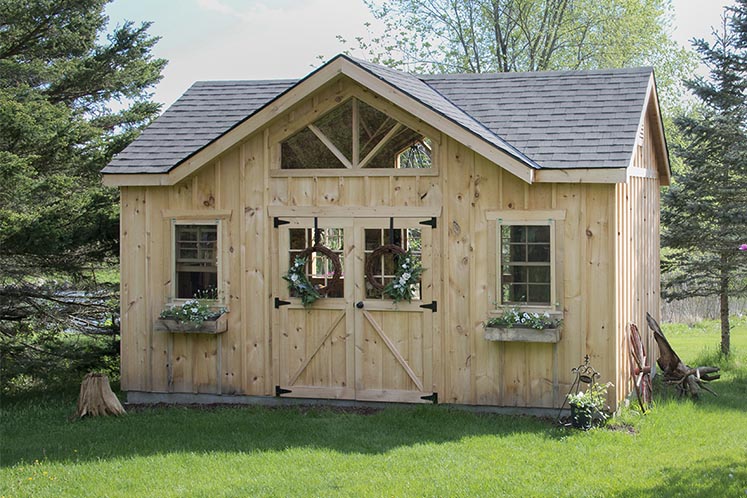
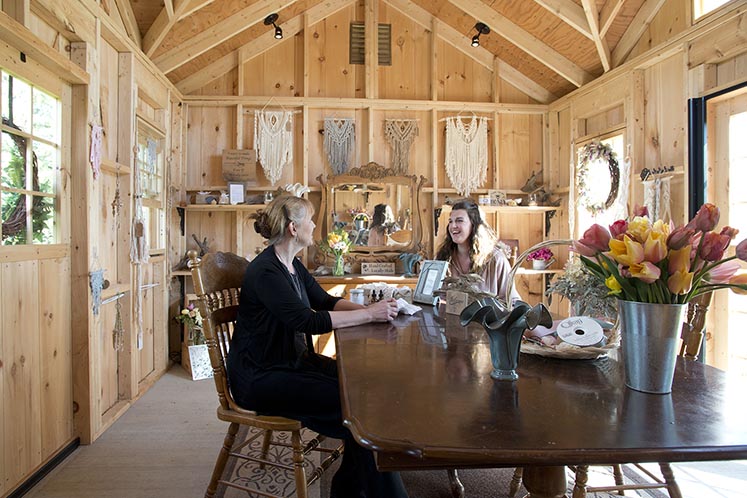
Constructed in 2021, a pine shed by Jay’s Custom Sheds serves as the three-season headquarters for mother-daughter duo Carolyn Young and Erica Storey and their new Caledon business, YS Florals. Photo by Pete Paterson.
For others, the construction of a backyard workspace doesn’t represent an evolution of their work style, but rather the basis of their entrepreneurship. To house their new Caledon business, YS Florals, Carolyn Young and Erica Storey commissioned a three-season combed-pine shed from Jay’s Custom Sheds in 2021 for Carolyn’s home on Mount Pleasant Road. By foregoing insulation, drywall and air conditioning, the mother-daughter duo has taken the path of many shed owners to keep costs down, says Jay’s Kalysta. And it works for them. “We were going to finish the walls, but when we saw how it looked with the bare wood, we thought it was the perfect rustic theme and a wonderful backdrop to the macramé products, fresh and dried floral arrangements, and other items we sell,” Carolyn says. At 12 by 18 feet, the shed is big enough to hold small workshops in the summer and fall. A powerful space heater kept the space toasty for holiday events in November and December. After that the pair closed until May when the screen doors reopened to a view of the flower garden, and to let in the spring breezes and birdsong.
This is Carolyn’s early retirement project – and after a career in finance with an hour-and-a-half daily commuting time, she now loves taking just a few steps out to her tranquil workspace. The pair wasn’t keen to rent retail space and be tied to opening hours. Erica lives with young children in nearby Colgan and appreciates the flexibility as well. “This is perfect for me at this stage of life and I can’t wait to grow it in the years to come.”
They’re not the only florists who have been snipping stems and arranging bouquets in a backyard design studio. Krystal Young of Snowberry Botanicals inherited a roughly 15-by-20-foot workspace when she bought her home six years ago in Erin; it was formerly used as an upholstery business. Krystal had a store on Main Street at the time, but found it too busy to juggle both retail and events, so in early 2019 she transitioned to her home studio to focus solely on events and weddings.
While she enjoys her retrofit, she’s planning to return to Main Street as one of the vendors in the soon-to-open Rural Commons communal workspace and retail location. “Over the pandemic the retail side picked up again as clients wanted to send flowers to friends and family throughout lockdowns and tough times,” Krystal says. “I also truly missed seeing and interacting with my regular customers, so I decided to go back to a storefront to accommodate the demand for retail again.”
Krystal’s experience is a reminder to anyone thinking of building a backyard workspace to consider when and how often you’ll use it, and whether your budget and needs align. In some cases, working at the kitchen table for just a few more months might be worth it.
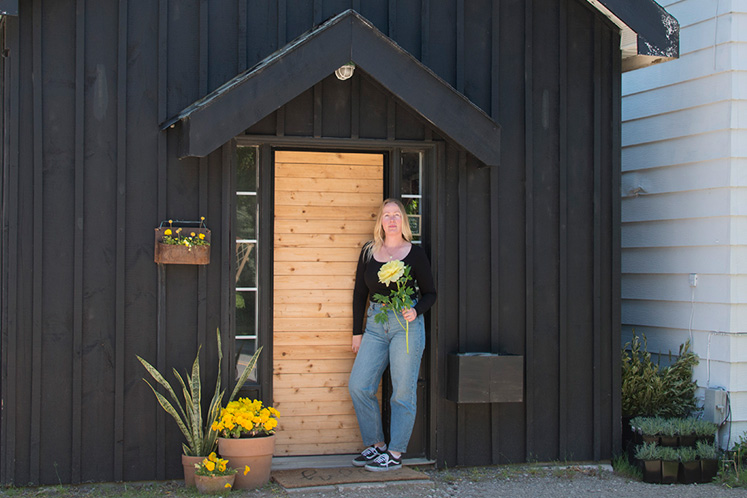
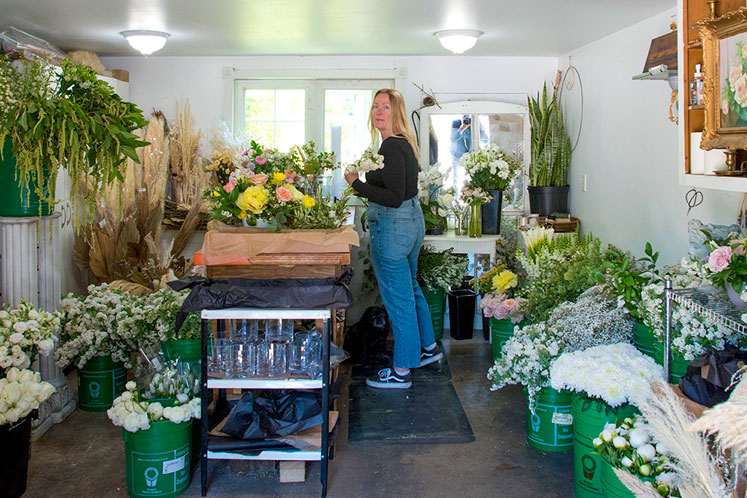
Florist Krystal Young of Erin’s Snowberry Botanicals has been working out of this chic black-painted workshop since 2019. As business returns to normal – including a backlog of weddings postponed by the pandemic – she’s soon moving back to a new communal storefront, Rural Commons, on Main Street. Photo by Pete Paterson.
“We have detailed and honest conversations with potential clients describing the sharp rise in material costs, especially for windows and doors, during the past two years. Sometimes that means the idea doesn’t go any further,” says Kalysta of Jay’s. She adds that if you’re hoping for anything larger than about 160 square feet (officially, that’s 15 square metres), the Ontario Building Code requires a building permit, which adds time and fees to the mix. She advises clients to always double-check their local zoning bylaws before embarking on any project. (The code has been amended from 10 square metres – that’s about 107 square feet – as of April 29, 2022.)
If you’re keen and able to pull it off, take it from a veteran of home studio work that it could be a life-changing move. In 1995, landscape architect Karen Rosenbrock set up her office in a post-and-beam carriage house on the Mono Centre property she purchased in 1990. She restored the former barn-cum-workshop after a few years of living in the main house.
“I made a conscious choice to work from my home so that I could be present for my children as they were growing up,” Karen says. “It was a lifestyle decision, and I am proud that they saw me working hard at a career I was passionate about. Prioritizing a dedicated space was an investment in my work and myself. The restoration took the commitment one step further in reflecting my design aesthetic and ideology.”
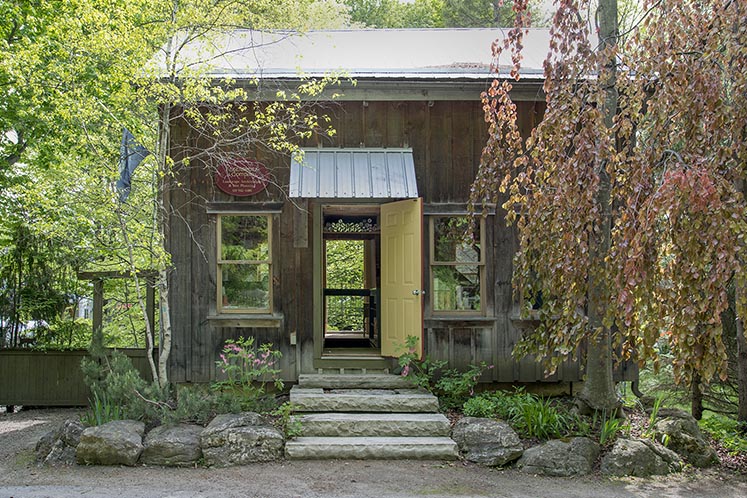
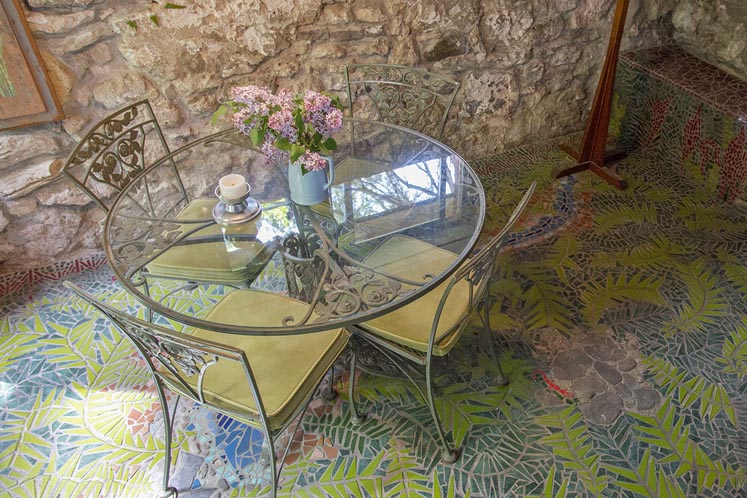
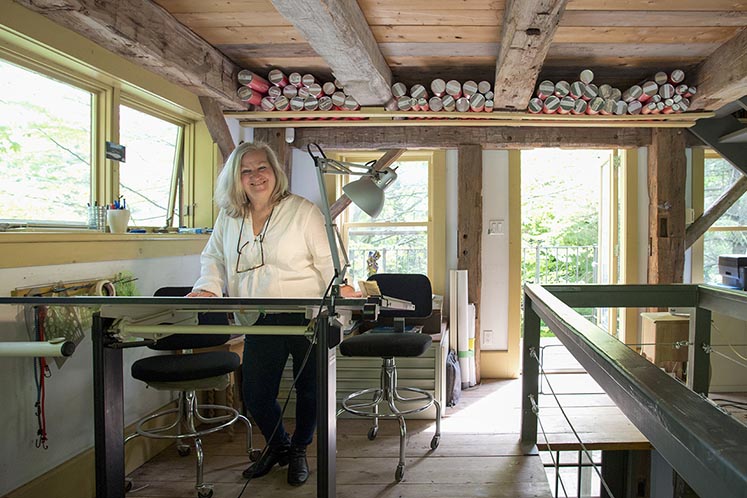
Mono landscape architect Karen Rosenbrock has plied her trade since 1995 in a three-storey former carriage house and barn she restored after moving to the property in 1990. Shown here is Karen in her main-level workspace, and a charming fern and salamander mosaic on the floor of the lower level. Photo by Pete Paterson.
The 20-by-20-foot building comprises three floors, and its earthy tones and whimsical design indeed reflect the style that Karen’s business, Rosenbrock & Company, is known for. The original hayloft is now a cozy library for researching and reading. The main level is the primary office space where Karen works on drawings at her computer and drafting tables.
A centre staircase leads to the lower level, with a rough stone foundation and an earthy mosaic floor designed by Karen and realized by local artist Saskia Post, featuring images of local ferns and Jefferson salamanders that live in the cliffs nearby. Karen uses this space for client meetings.
Karen’s studio is connected to her house by a 60-foot boardwalk she has affectionately nicknamed “The Mono Centre Bypass.” It provides both a physical and mental break between work and home, so those boundaries don’t blur.
Karen admits backyard work life isn’t for everyone. “But for a sole proprietor or someone who can work remotely almost all of the time, it could be perfect – I know it is for me.”
Related Stories
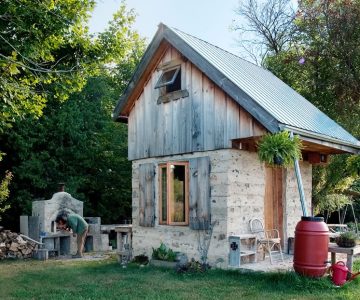
An Ode to the Tiny House
Sep 16, 2019 | | CommunityThe idea of living small is undeniably alluring. Some folks in these hills are doing more than flirt with the romantic fantasy.
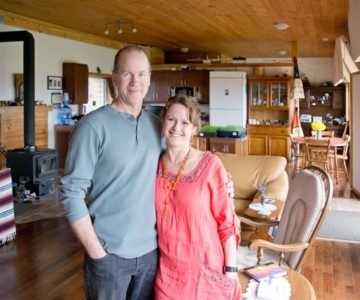
Going off the Grid
Jun 21, 2017 | | EnvironmentFor Mary and Brad Kruger, living lightly doesn’t mean sacrificing comfort for conscience.











Check out this great project we did in Caledon with Scott McGillivray as he walks through best practices on creating a backyard office shed.
Free plans and a cool video overview of the project.
http://rockwool.com/shed
Chris from Caledon on Jul 19, 2022 at 12:49 pm |